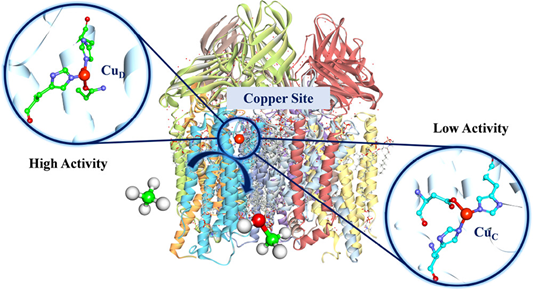我室王斌举教授在 JACS 上发表论文:Unraveling the Valence State and Reactivity of Copper Centers in Membrane-Bound Particulate Methane Monooxygenase
摘要:Particulate methane monooxygenase (pMMO) plays a critical role in catalyzing the conversion of methane to methanol, constituting the initial step in the C1 metabolic pathway within methanotrophic bacteria. However, the membrane-bound pMMO’s structure and catalytic mechanism, notably the copper’s valence state and genuine active site for methane oxidation, have remained elusive. Based on the recently characterized structure of membrane-bound pMMO, extensive computational studies were conducted to address these long-standing issues. A comprehensive analysis comparing the quantum mechanics/molecular mechanics (QM/MM) molecular dynamics (MD) simulated structures with cryo-EM data indicates that both the CuC and CuD sites tend to stay in the Cu(I) valence state within the membrane environment. Additionally, the concurrent presence of Cu(I) at both CuC and CuD sites leads to the significant reduction of the ligand-binding cavity situated between them, making it less likely to accommodate a reductant molecule such as durohydroquinone (DQH2). Subsequent QM/MM calculations reveal that the CuD(I) site is more reactive than the CuC(I) site in oxygen activation, en route to H2O2 formation and the generation of Cu(II)–O•– species. Finally, our simulations demonstrate that the natural reductant ubiquinol (CoQH2) assumes a productive binding conformation at the CuD(I) site but not at the CuC(I) site. This provides evidence that the true active site of membrane-bound pMMOs may be CuD rather than CuC. These findings clarify pMMO’s catalytic mechanism and emphasize the membrane environment’s pivotal role in modulating the coordination structure and the activity of copper centers within pMMO.

文章链接:https://pubs.acs.org/doi/10.1021/jacs.3c08834